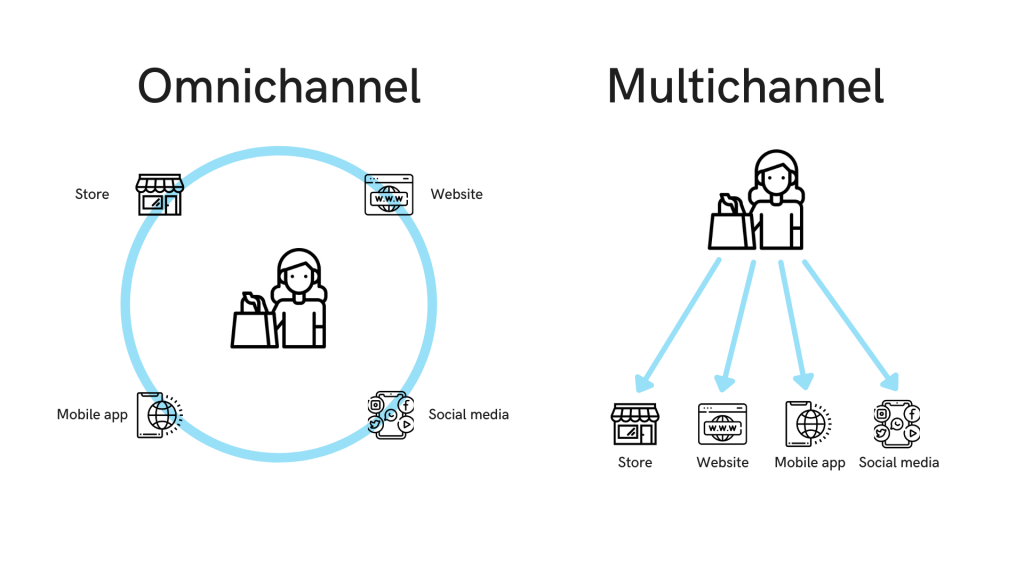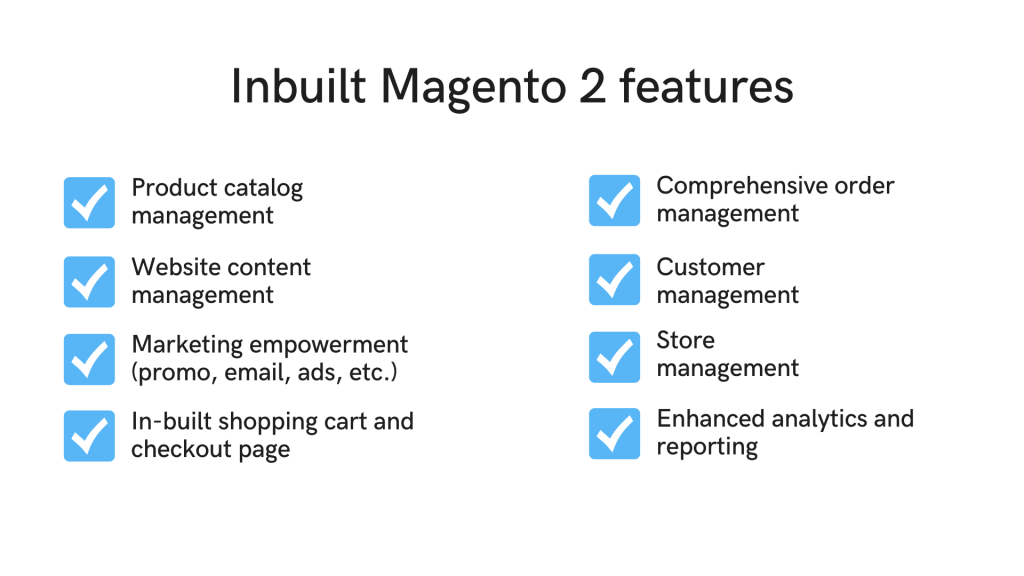Let’s talk numbers to help you understand why omnichannel became a buzzword in retail lately.
Over the past year, in-store sales in the US reminded of a rollercoaster, with constant rises and falls:

While digital/omnichannel sales experienced boost:
- Retail e-commerce sales grew by more than 50 billion US dollars since Q1 2020, reaching 215+ billion US dollars in Q1 2021.
- 86.2% of Millennials, 79.2% of Gen X, and 62.1% of Baby boomers prefer online shopping.
- Though the share of e-commerce in total US retails sales increased with the spread of COVID-19, it accounted for only 13.6% in Q1 2021.
Customers do become more connected and demanding. Yet, lots of them prefer old-school in-store shopping. This makes businesses look for multiplatform solutions that orchestrate communication channels and increase revenue (or, at least, allow to keep up with pre-pandemics earnings). Let’s see how Magento omnichannel can help with that.
What is Omnichannel?
Omnichannel is not only being where your consumers are, but also ensuring all the touchpoints are aligned to provide a smooth transition between them. This means unifying brick and mortars, mobile apps, websites, social media, and other channels.
Here’s how it differs from multichannel experience:

For example, your customer can buy your products online and pick them at the store or request delivery. Or chat with your support team on Facebook and finish their order through a website/mobile app.
Omnichannel Benefits
Aberdeen research indicates: companies that opt for omnichannel engagement with their consumers, retain around 89% of clients, as compared to 33% retention rate for those businesses that don’t have a solid omnichannel strategy.
Check out a few more benefits of creating an integrated omnichannel ecosystem.
Meet Customers Where They Are
And by saying that, we mean they are literally anywhere—looking for info about your products in Google, at marketplaces, on your website, mobile app, or in social media. Going digital impacts their shopping behavior, and the following numbers prove it:
- 3 in 4 customers, who find relevant and useful info in Google, are more likely to visit physical stores. The same research discovered that 71% of brick and mortar shoppers said using smartphones for research became more important in offline purchases.
- In 2020, nearly 9 out of 10 clients read online reviews about local businesses when choosing where to buy products.
- 83% of consumers note that a recommendation from family or friends influences their shopping choices. 55% of respondents are eager to recommend a service, store, or product to their close ones if they enjoyed the experience.
But digital doesn’t eliminate the need for physical stores, where people can try your products on or check how they are working. This is why covering and integrating multiple offline and digital touchpoints will help you gain you more loyal customers, who can become your brand advocates.
Stand Out in a Competitive Retail Industry
The bad news about this digital story is you’re not the only one looking for a silver bullet to grab customers’ attention and boost your sales. The good news is that by leveraging omnichannel strategy properly, you do stand out in the crowd of your competitors who still use one way of engagement with the clients.
Companies that use omnichannel, as compared to those that use a single channel, have:

Enhance Your Business With Data and Analytics
With such a variety of ecommerce channels, you may wonder which of them might work better for you. Omnichannel helps you figure it out by centralizing your product data from different touchpoints. Thus, you can get a comprehensive view of your clients’ needs and adjust your order flow accordingly to meet them at the right time and on the right channel.
Here are a few examples of how your company can benefit from omnichannel analytics:

Offer Flexible Order Fulfillment Options
During 2020, “click and collect” sales rose by 60.4% in the US, as compared to 2019 and reached 58.52 billion U.S. dollars.
As mentioned above, people prefer to choose and purchase products online, yet pick them in-store or buy something in brick-and-mortar and order home delivery. A vivid example of these customer shopping preferences is the furniture business, though it can be related to electronic appliances, as well as other spheres.
Now that you know the major advantages of creating an ecosystem of multiple channels, you may wonder how Magento omnichannel solution can help you improve customer engagement and boost sales. Let’s check it out.
Why is Magento 2 the Best Platform for Omnichannel Commerce?
Magento is a flexible platform with lots of extensions that enables you to build a feature-rich website and smoothly integrate it with other tools and channels you use. Some of the Magento features include:

Let’s focus on features that contribute to your Magento omnichannel strategy more than others.
Third-Party Integrations
Because Magento is an API-led platform, integrating your ERP (Enterprise Resource Management) and PIM (Product Information Management) systems with your website becomes as easy as a breeze. This way, you’ll address all your procurement issues, centralize info about stocks, and distribute inventory equally across diverse sales channels. You can also make sure your available supply is always up-to-date, which means your customers won’t be disappointed when they click on your product only to find out it’s not in stock.
You can also request more Magento integration services, like shipping, payment gateway, accounting software, CRM, or marketing automation systems integration.
Social Media Integration
To consolidate your social media activities with your sales, you can use pre-designed Magento 2 omnichannel extensions and modules that will help to kick-start your omnichannel approach. Among others, these are:
- Facebook business extension
- Facebook Pixel
- Instagram integration
- Twitter widget and more
On top of that, you can use the Social login module to help your customers register and sign in to your website faster.
Mobile/Shopping App
With over 294 million of smartphone users in the US, you can’t ignore optimizing your website for mobile devices, or even developing an iOS or Android app.
The simplest way to deal with this challenge is to create a Progressive Web Application (PWA), which is actually your website, wrapped up into a mobile-friendly view. Your customers can install a shortcut of such an application on their smartphone and get full access to your website that is displayed as an app.
Thanks to Magento PWA studio, creating a progressive web application has never been that easier.
In-Store Experience
Brick-and-mortar sales still hold the larger share of the market. Your task is to reinforce the in-store shopping with what an omnichannel Magento 2 solution can offer.
If you have several seller accounts on some marketplace, you can easily link them and manage from a single space, as well as handle all your data and products there.
Magento also empowers you to support multiple currencies, which makes purchases a lot easier for customers who are used to paying in certain currencies.
Finally, you can integrate real-time tracking of products to provide your clients with the latest information about how shipping is going on.
Business Intelligence
You can’t create a truly personalized customer experience without analyzing your clients’ behavior. The point of using Magento for omnichannel interactions is capturing data about your customers’ preferences, most popular products, marketing campaigns efficiency, and analyzing it.
These in-depth insights will allow you to:
- Identify your top customers and make special offers to them.
- Understand which products are more or less popular and adjust your stock.
- Define which communication channels are driving more sales and adapt your promotional activities.
- Enrich your online store with additional features to increase conversion into purchases.
Magento Omnichannel: Wrapping Up
To sum it up, omnichannel in retail gains momentum and opens nearly unlimited opportunities for businesses to get more customers. Yet, going omnichannel isn’t that easy— you have to be digitally mature. Your customers will look for consistency across the channels they use, and if you fail to meet their expectations, they’ll find someone who won’t.
Magento will have your back by providing the most crucial functionality for creating an omnichannel experience. All you have to do is to make sure your current ecosystem is ready to embrace the change.
Our Magento experts have got you covered
Request Magento 2 development services

